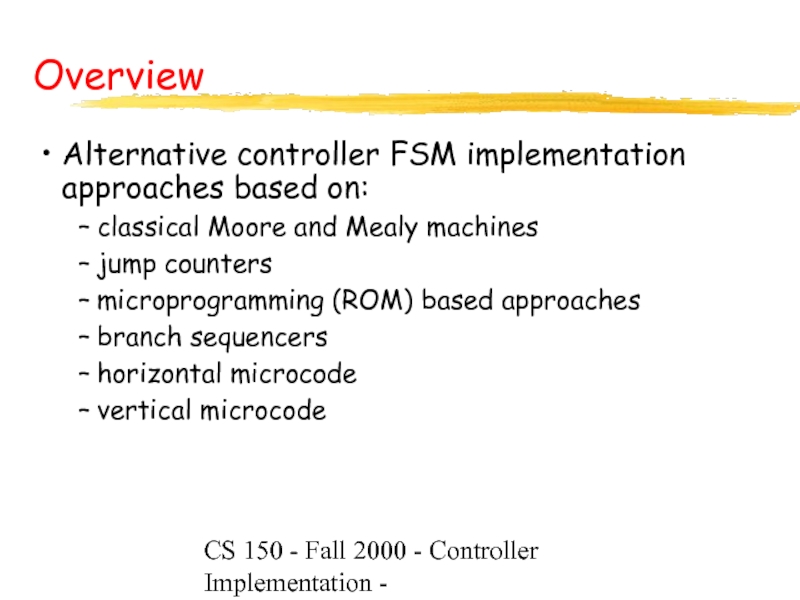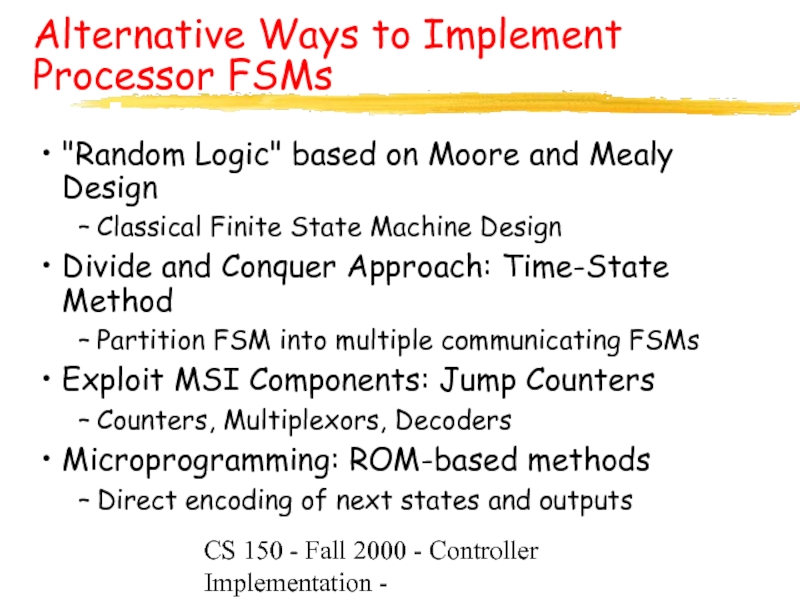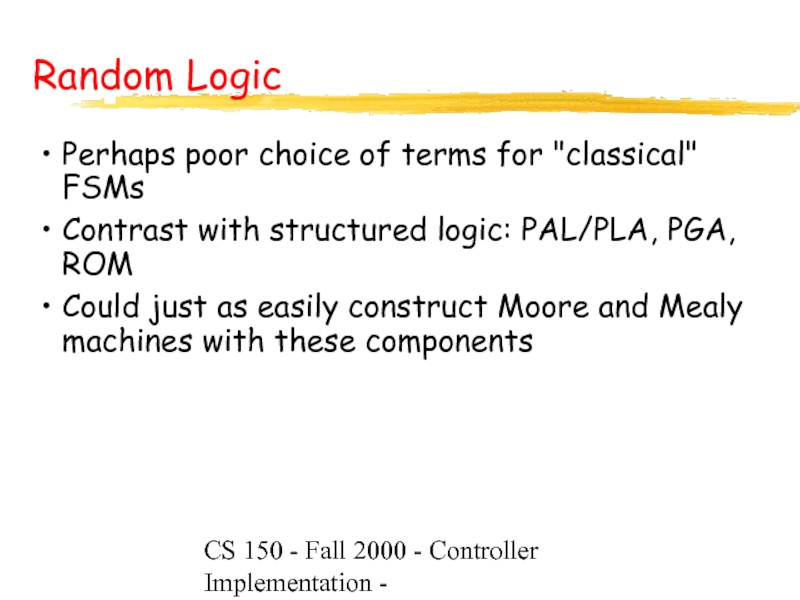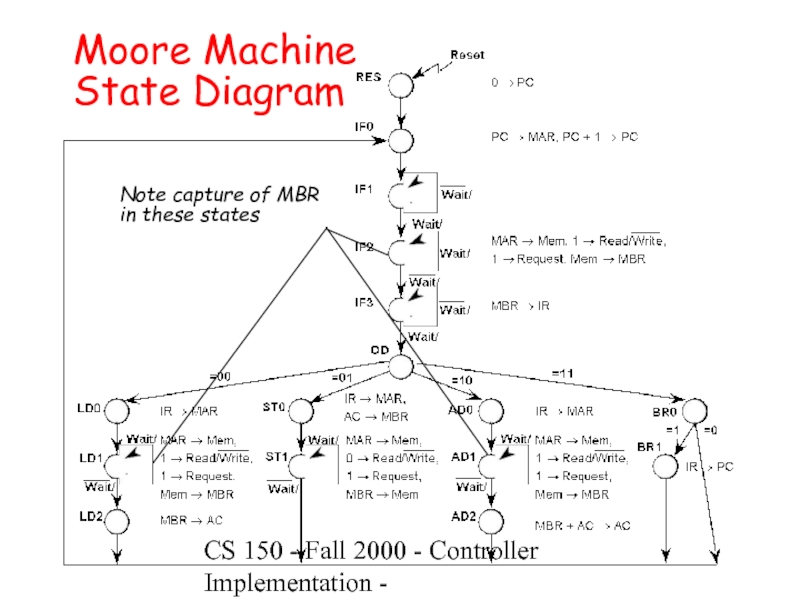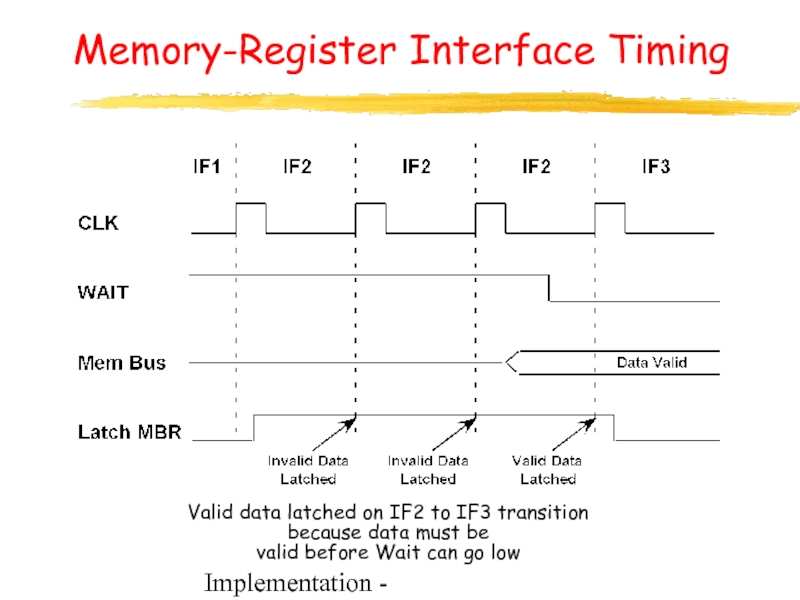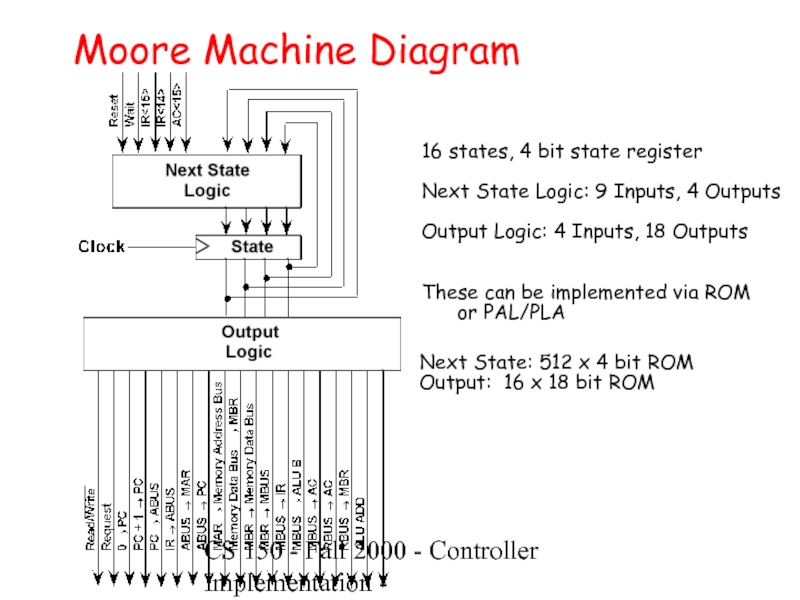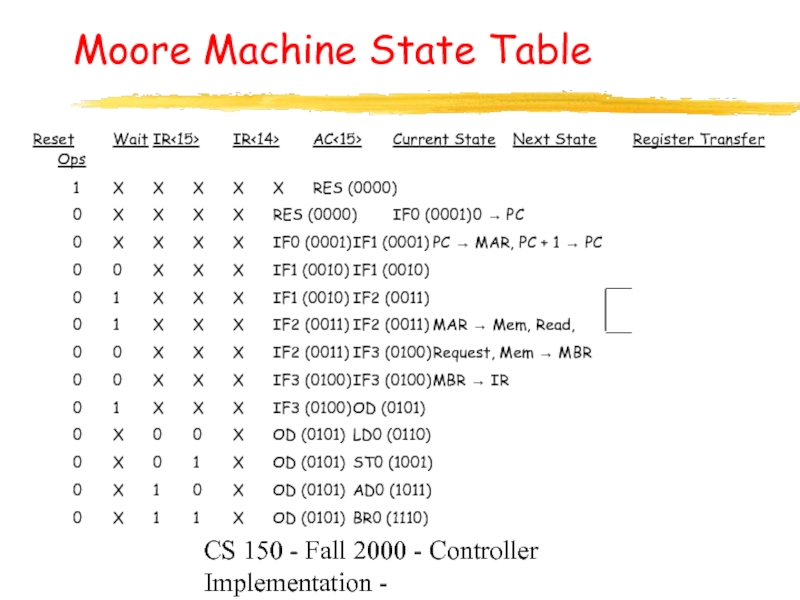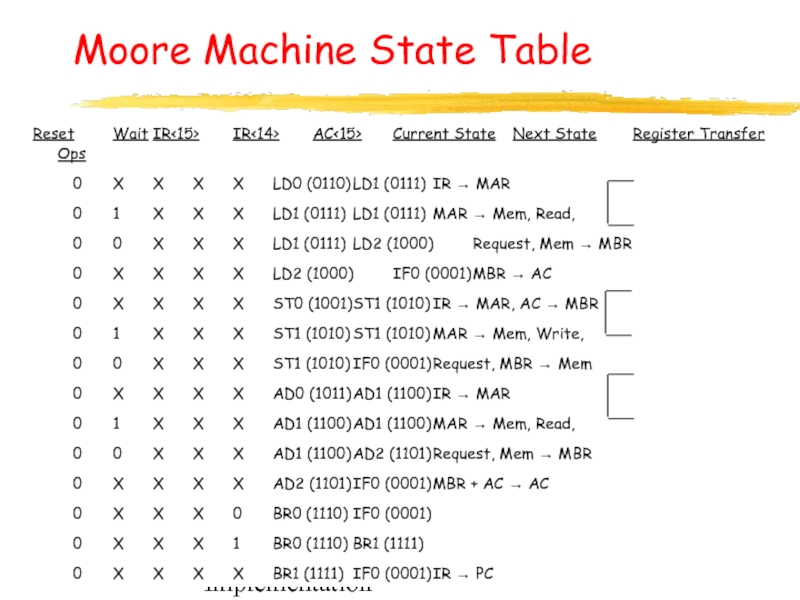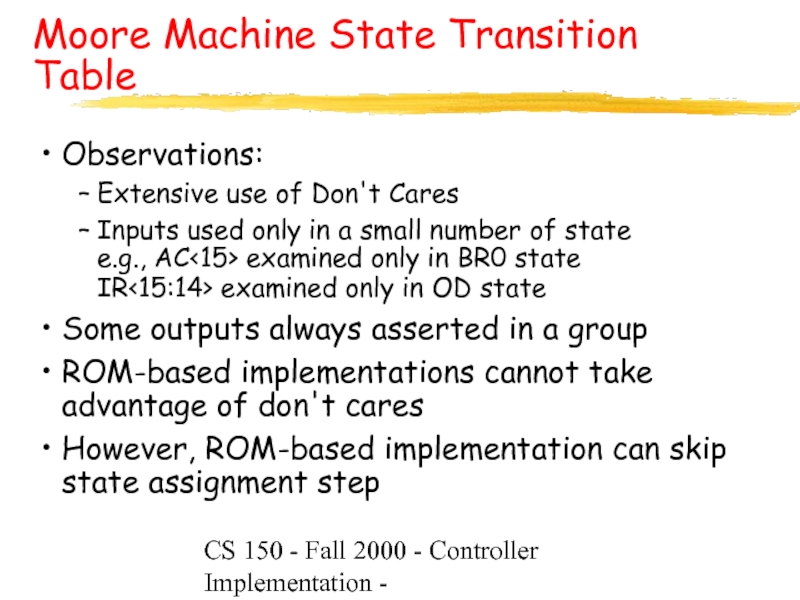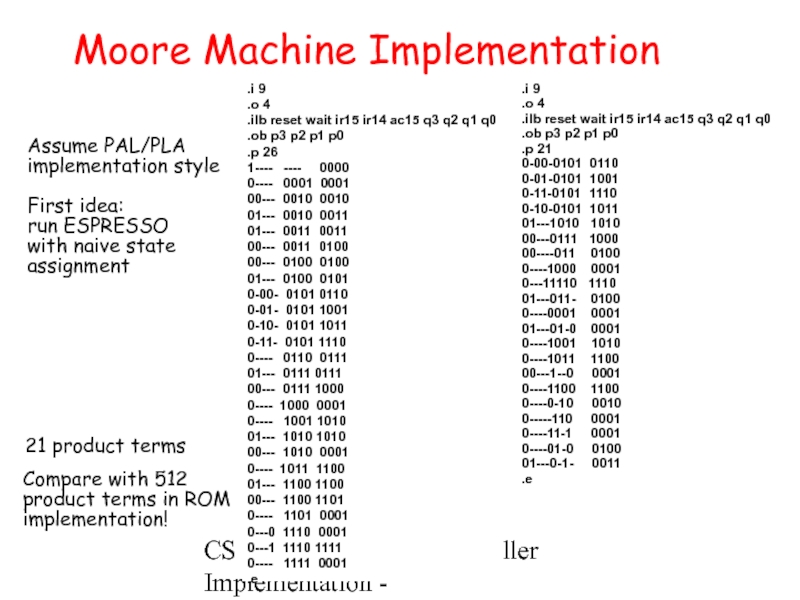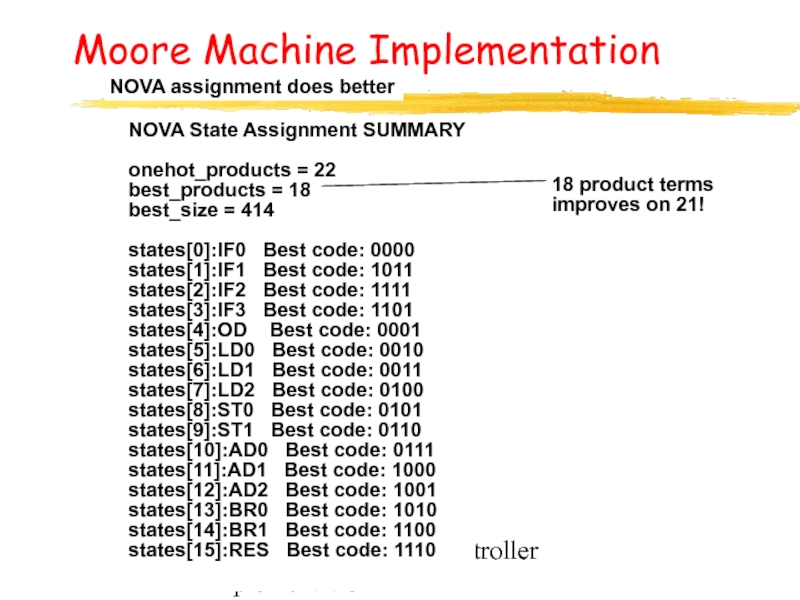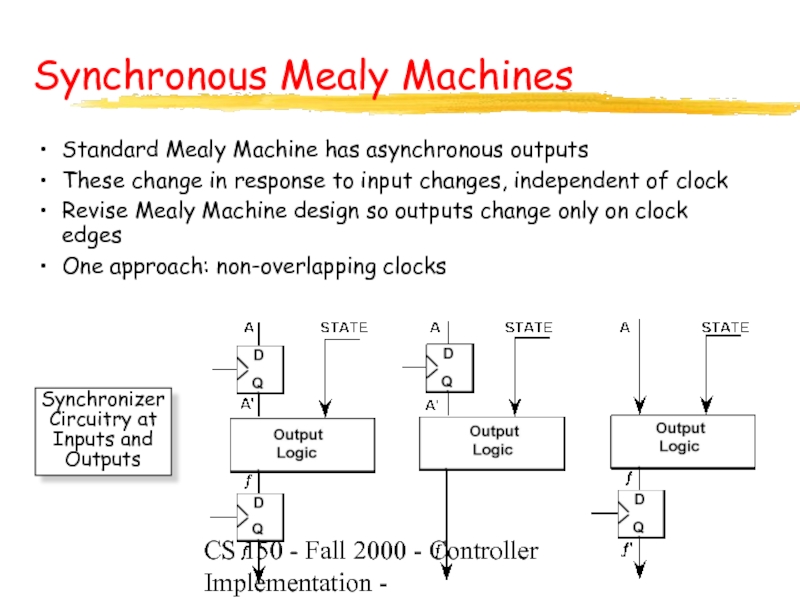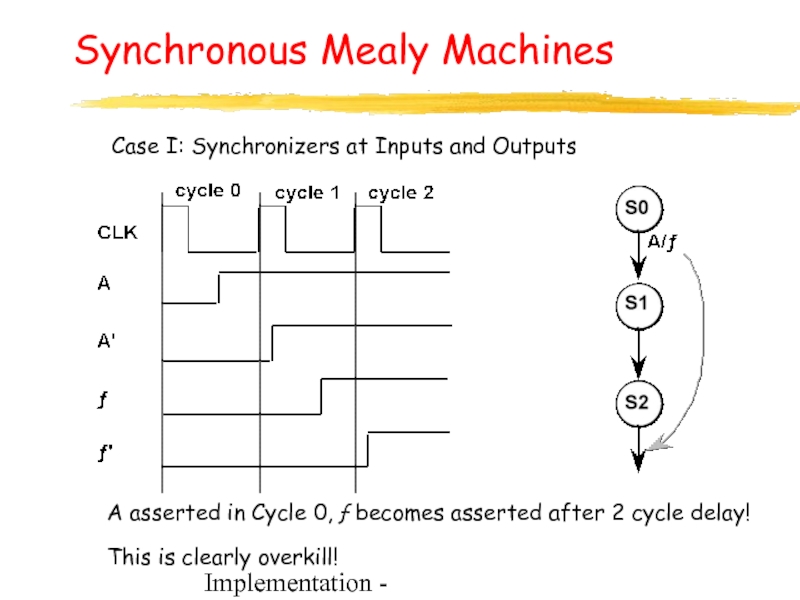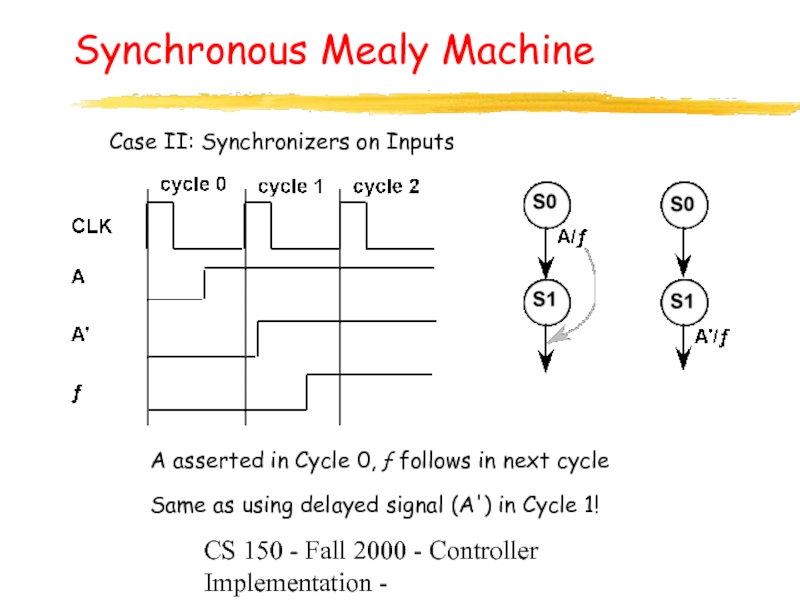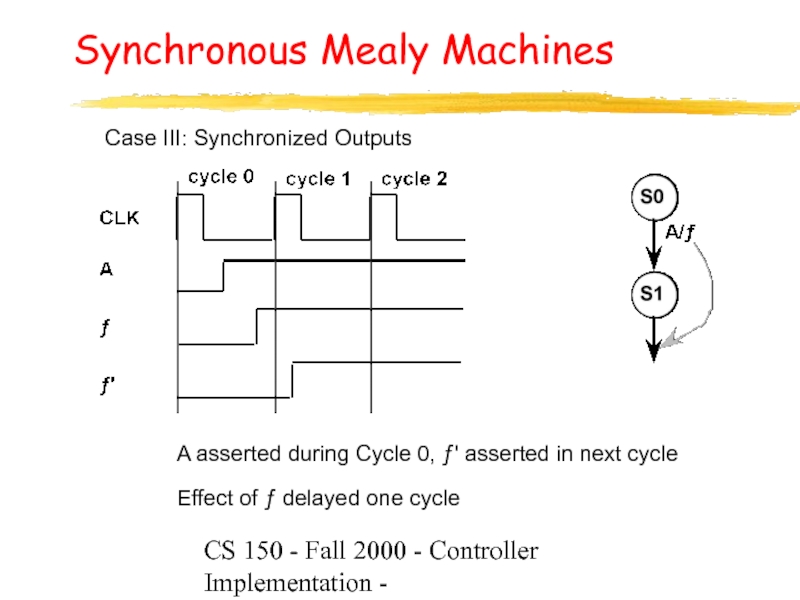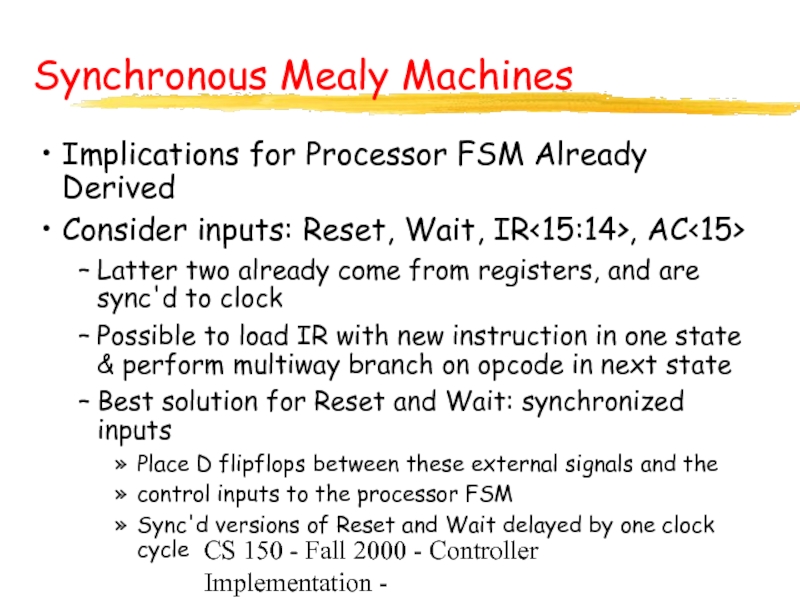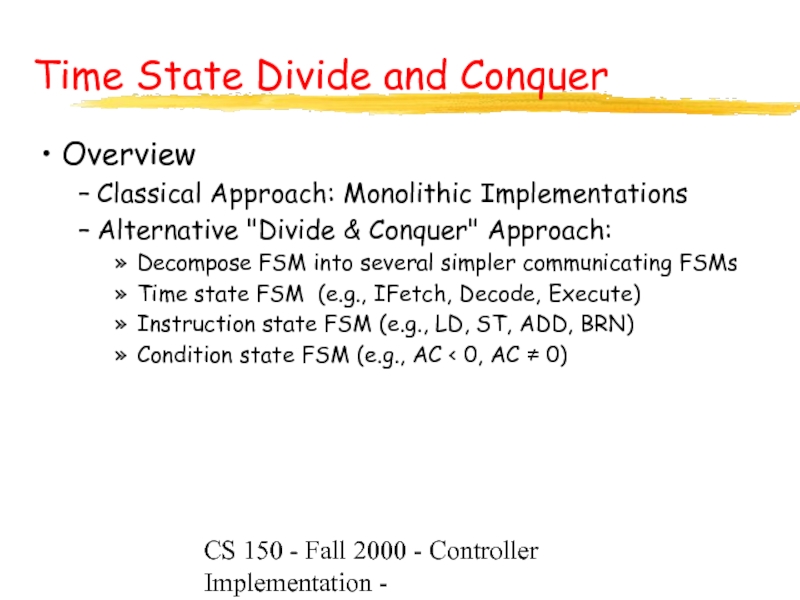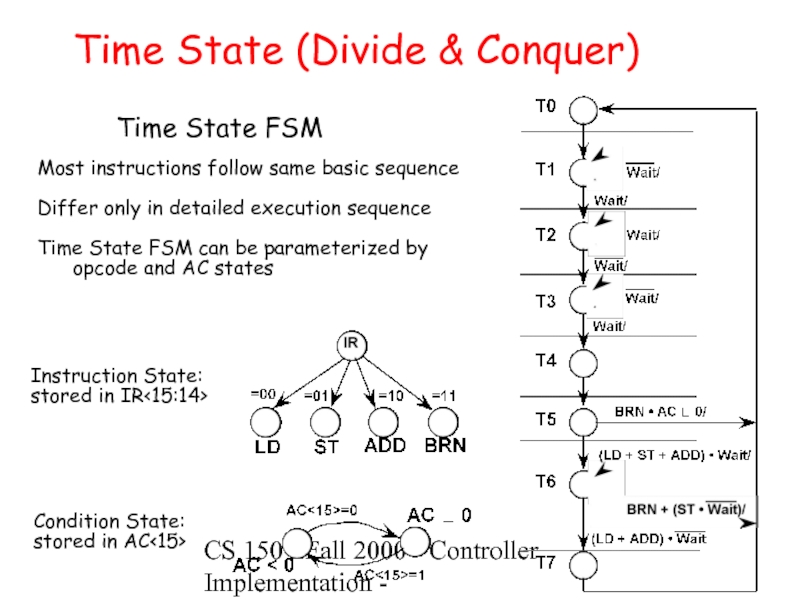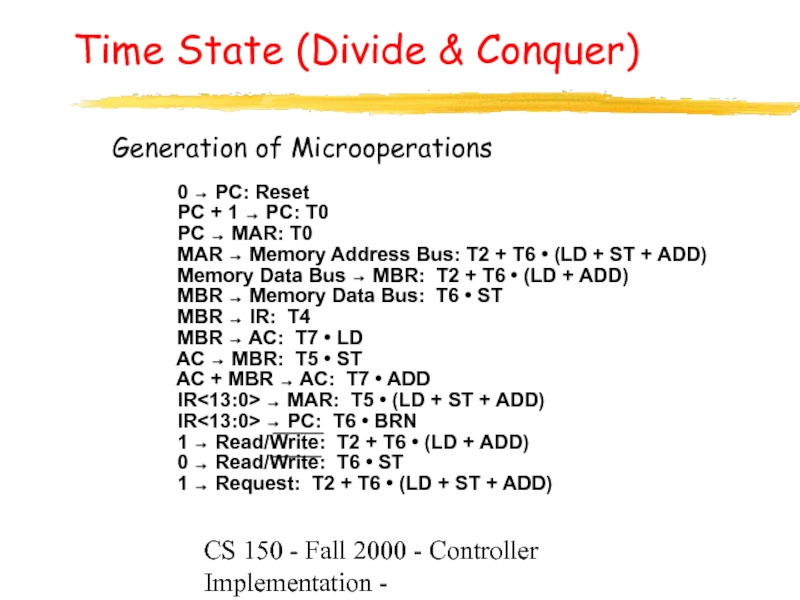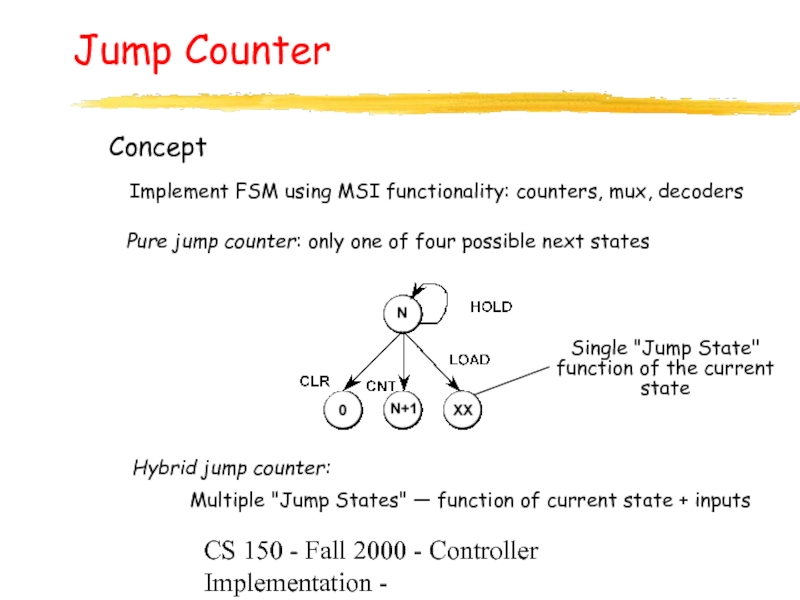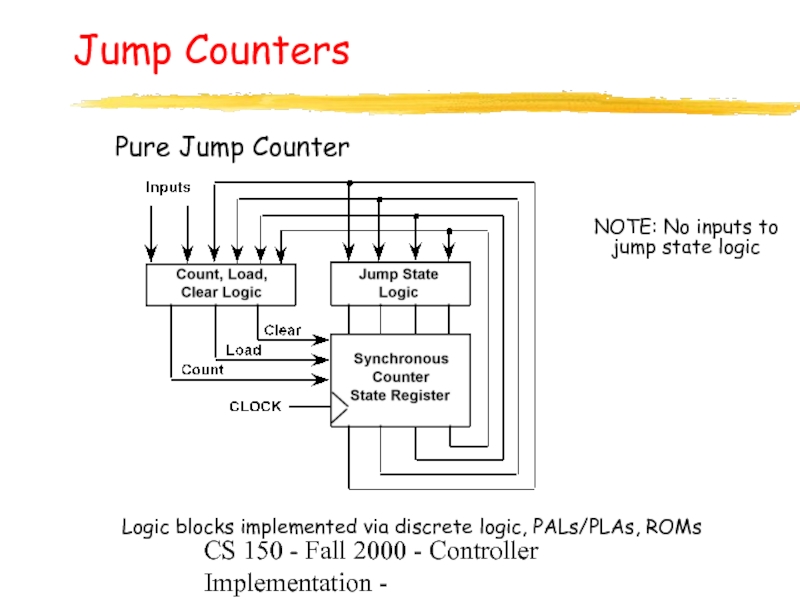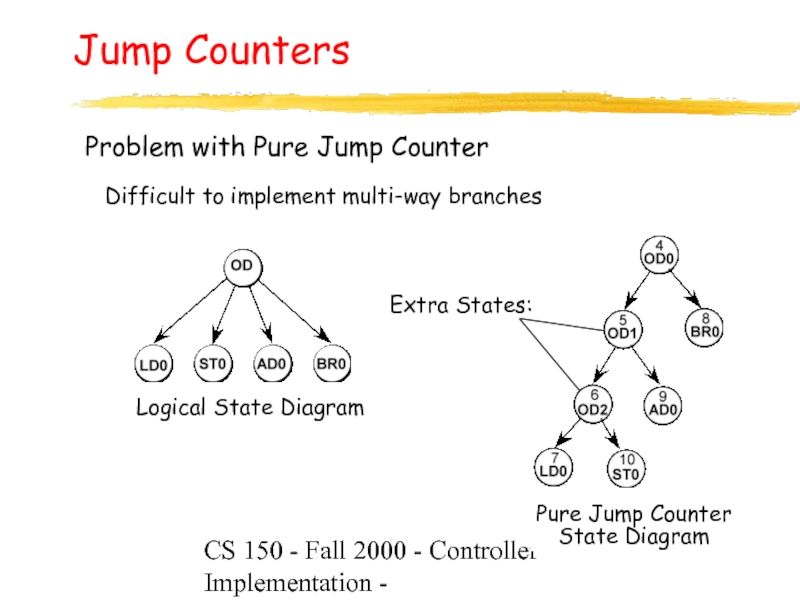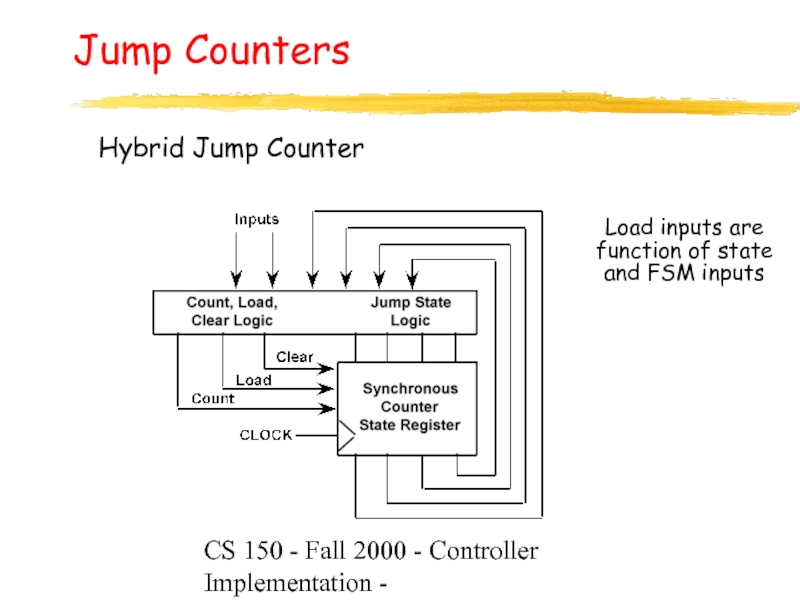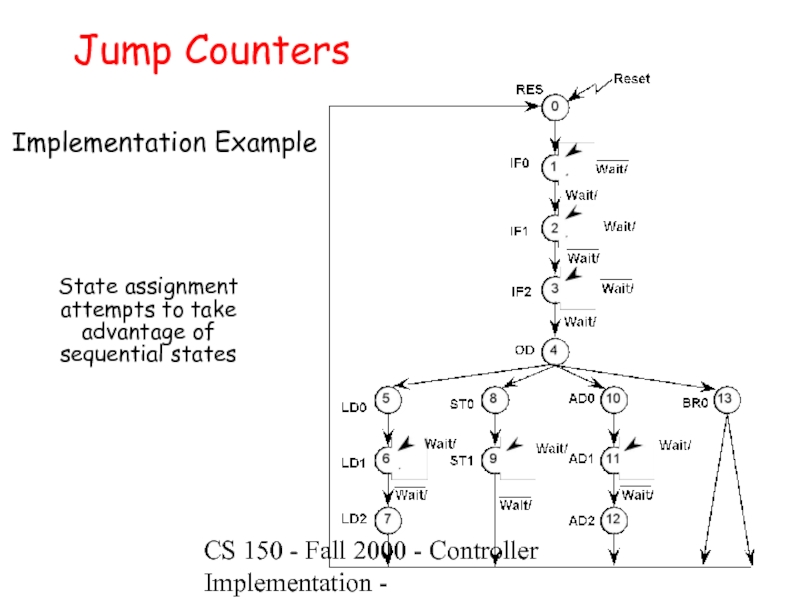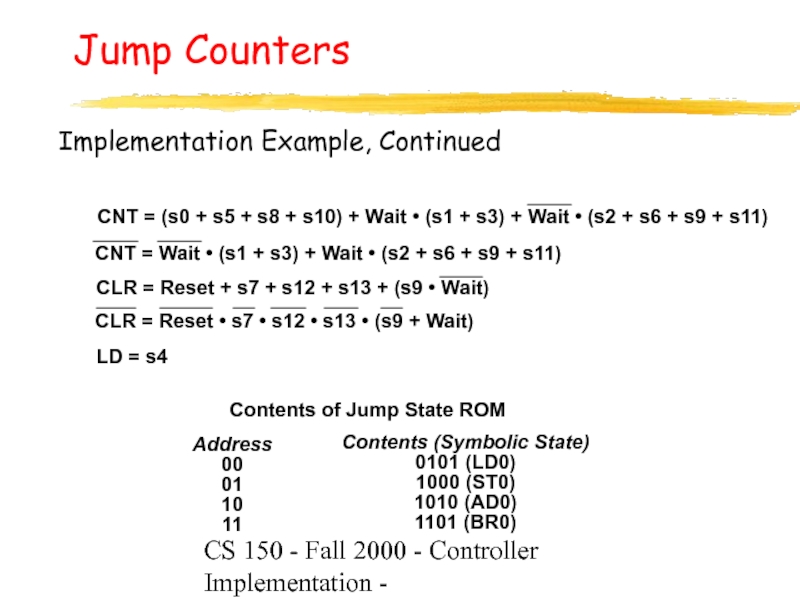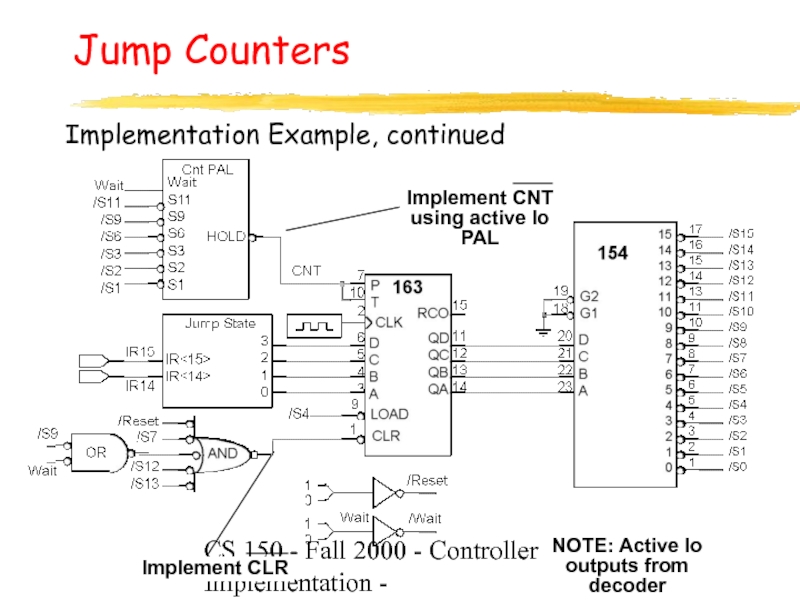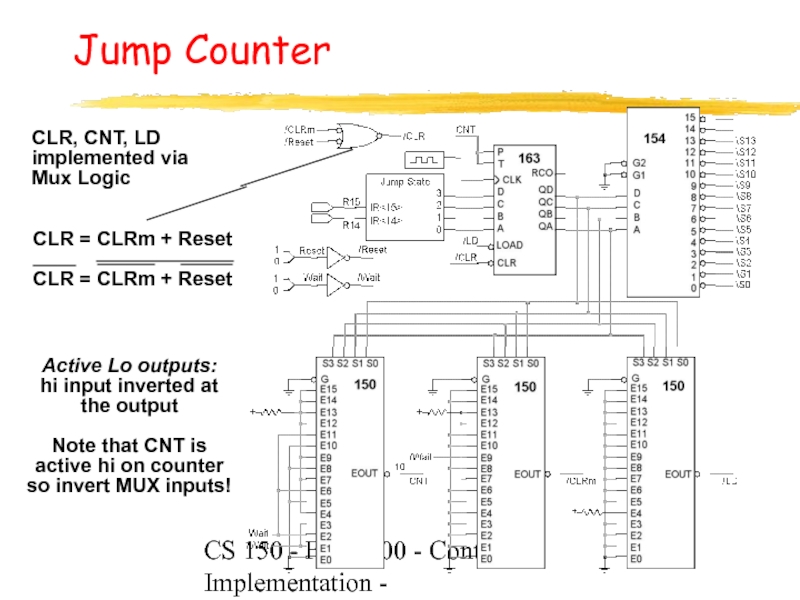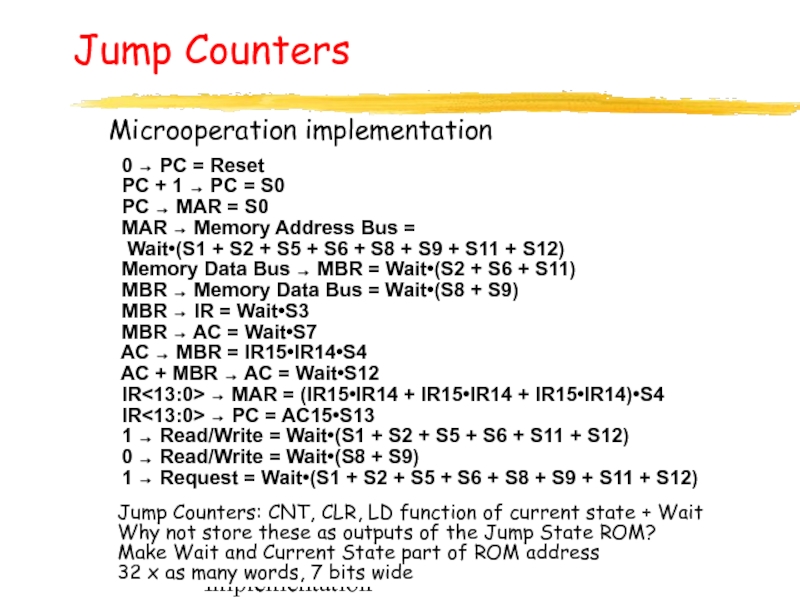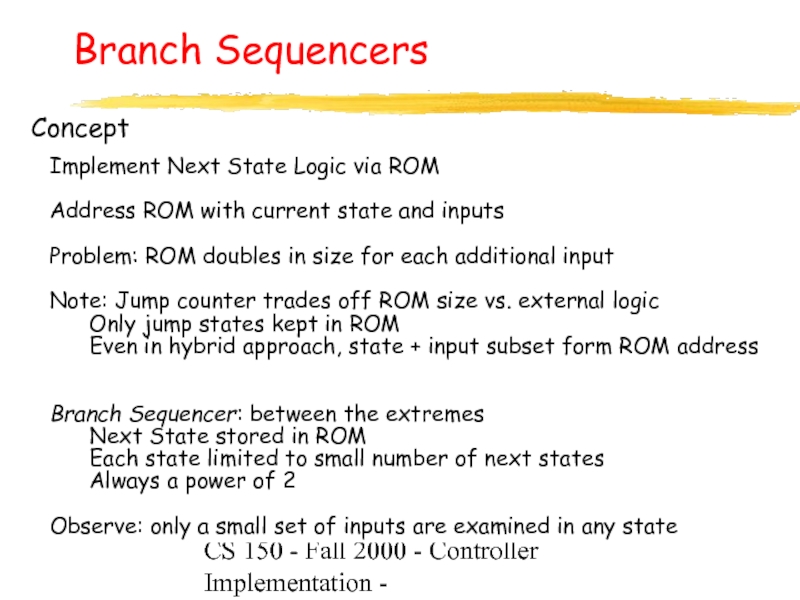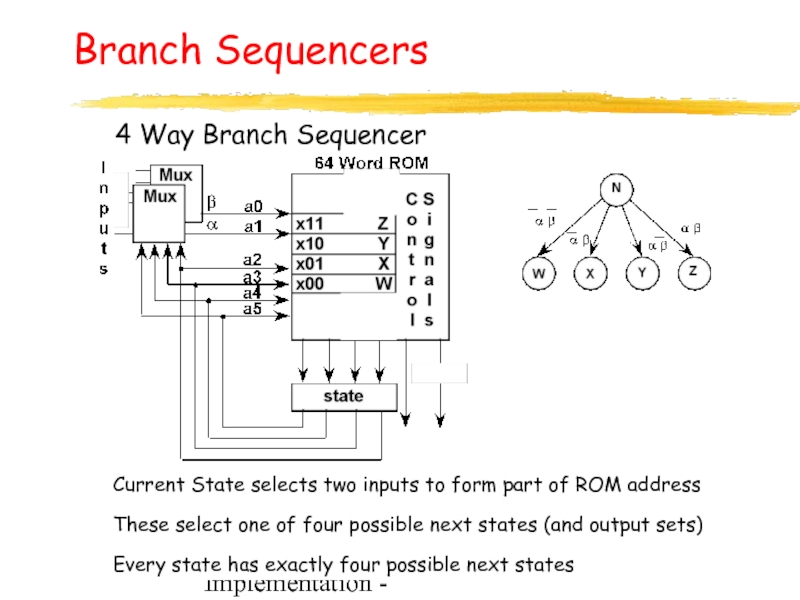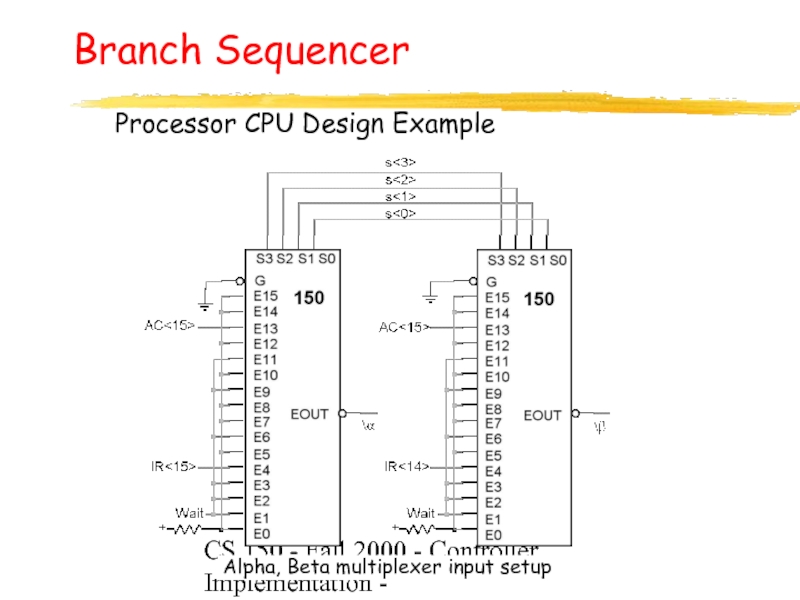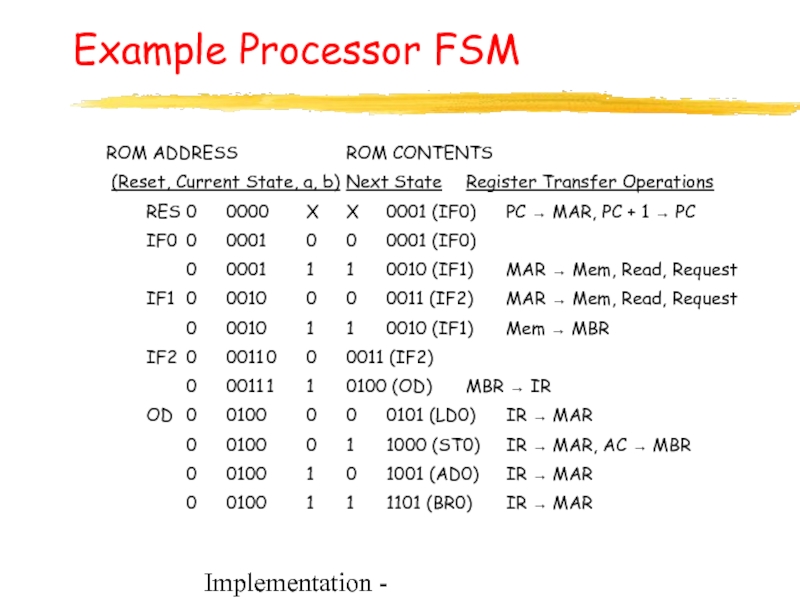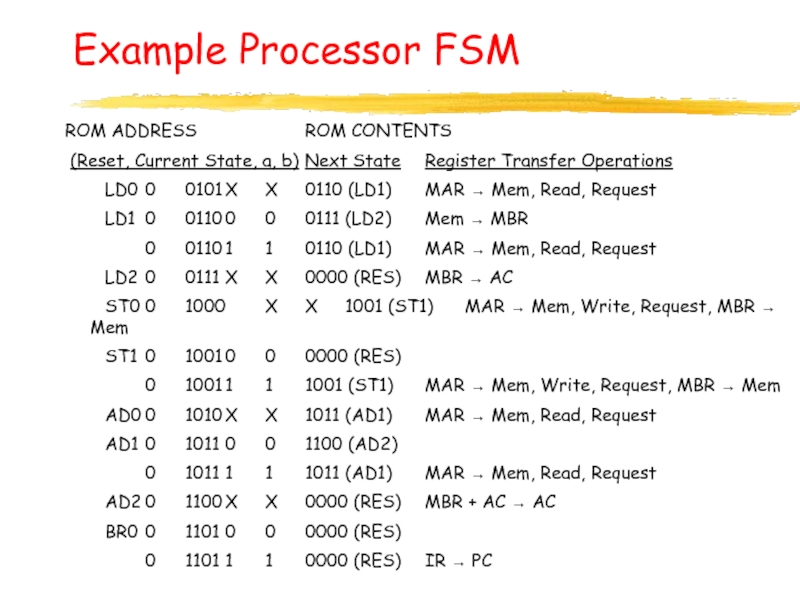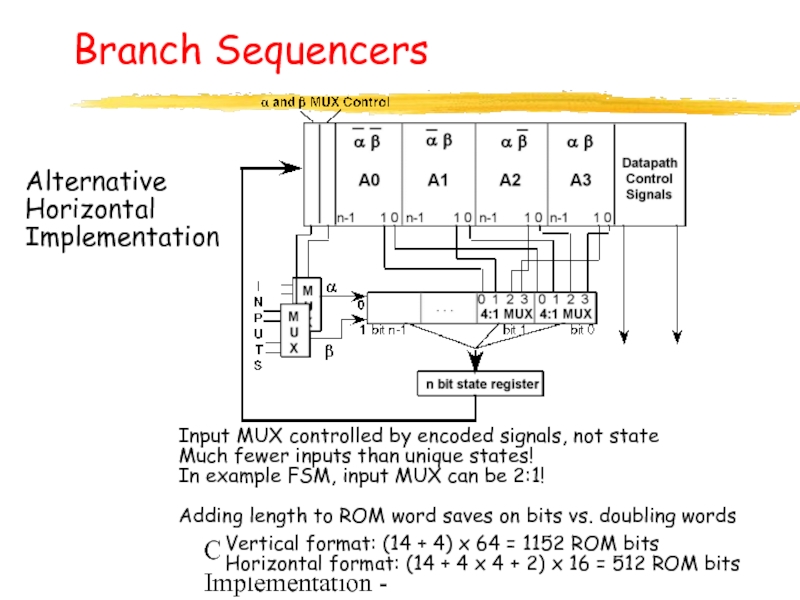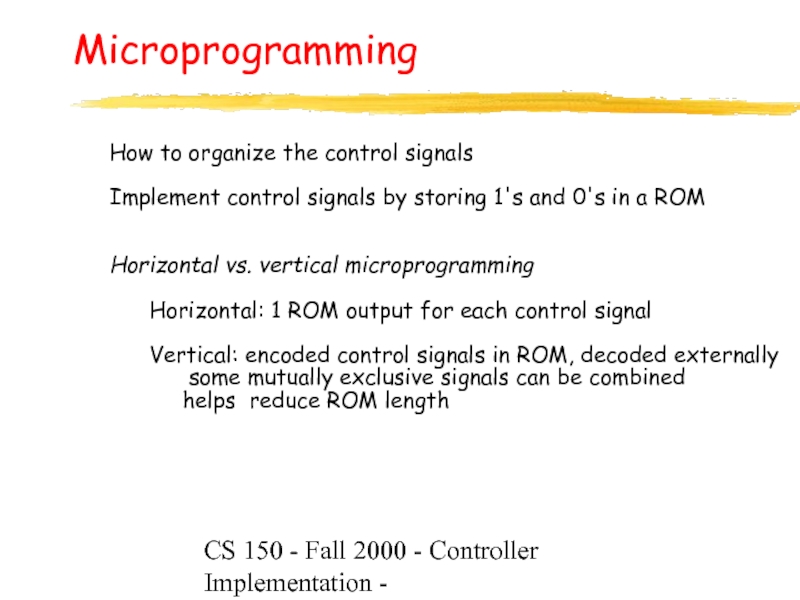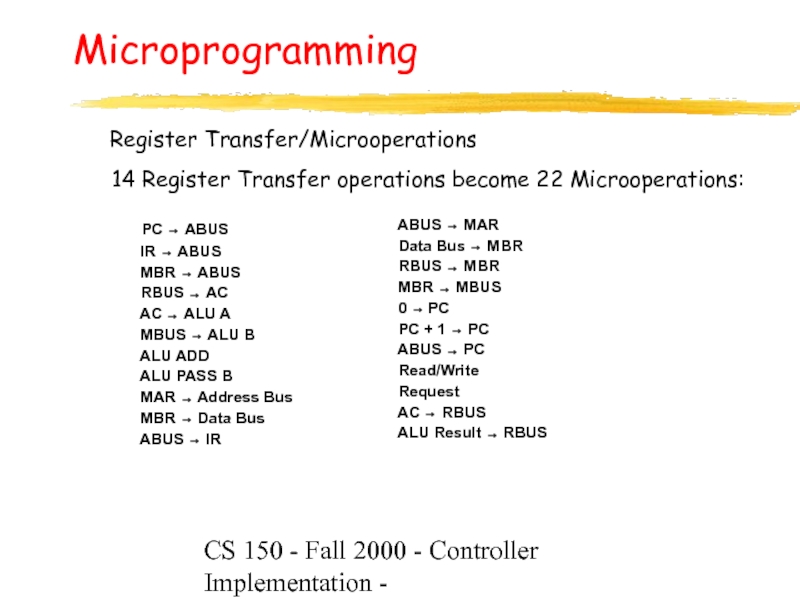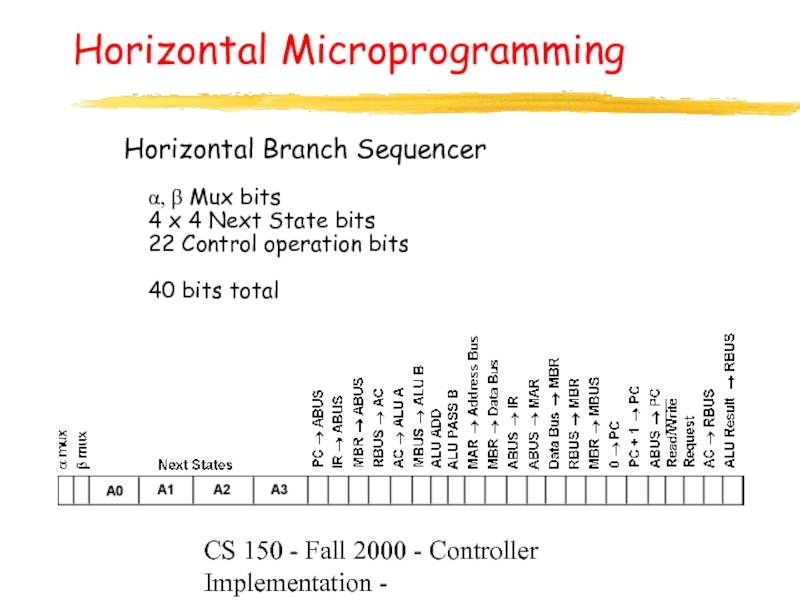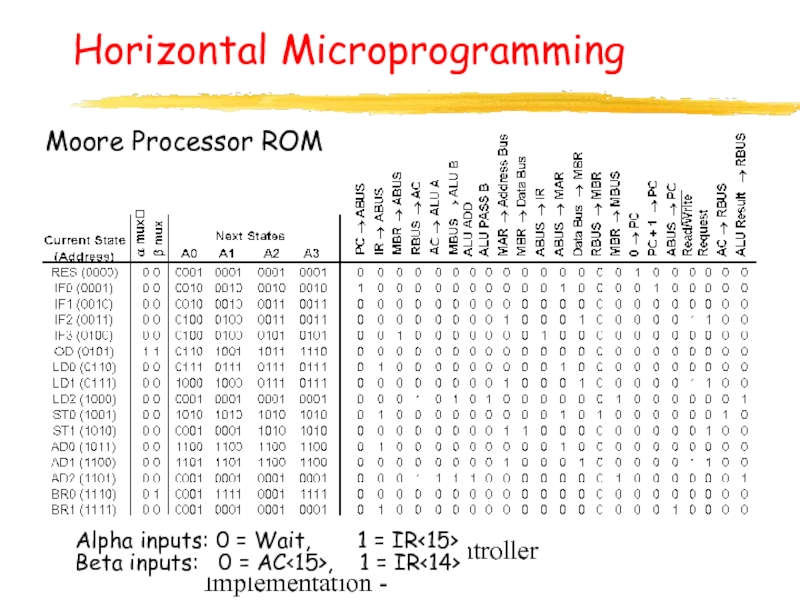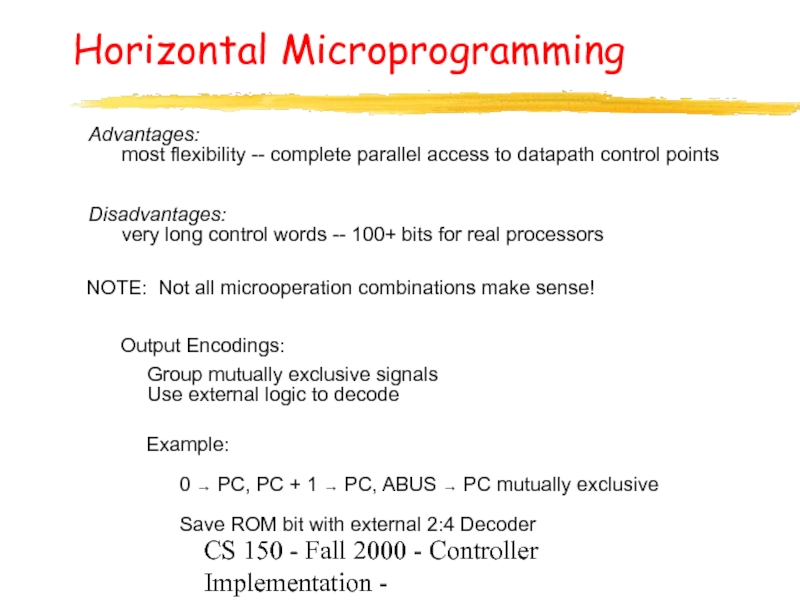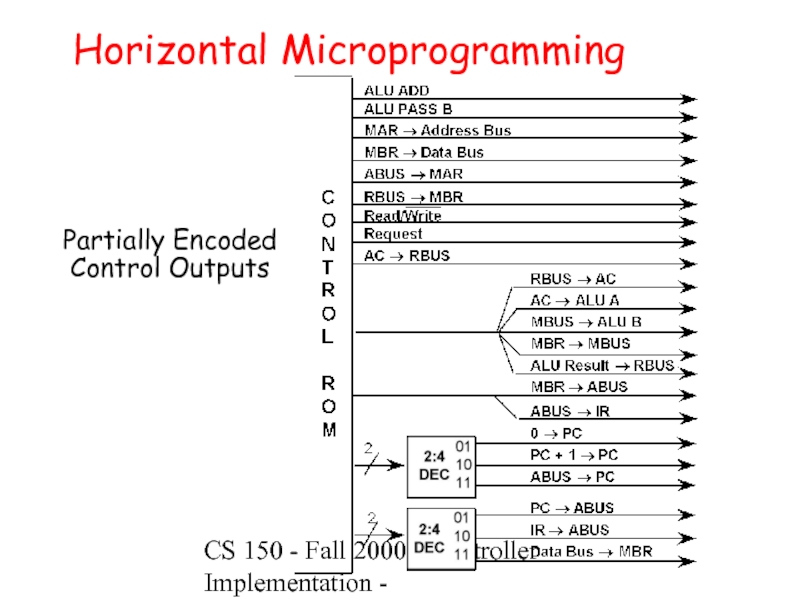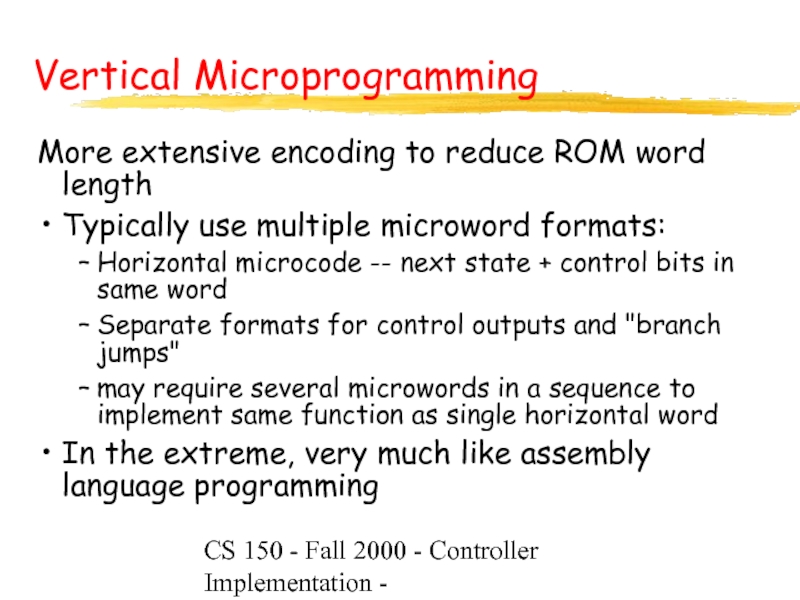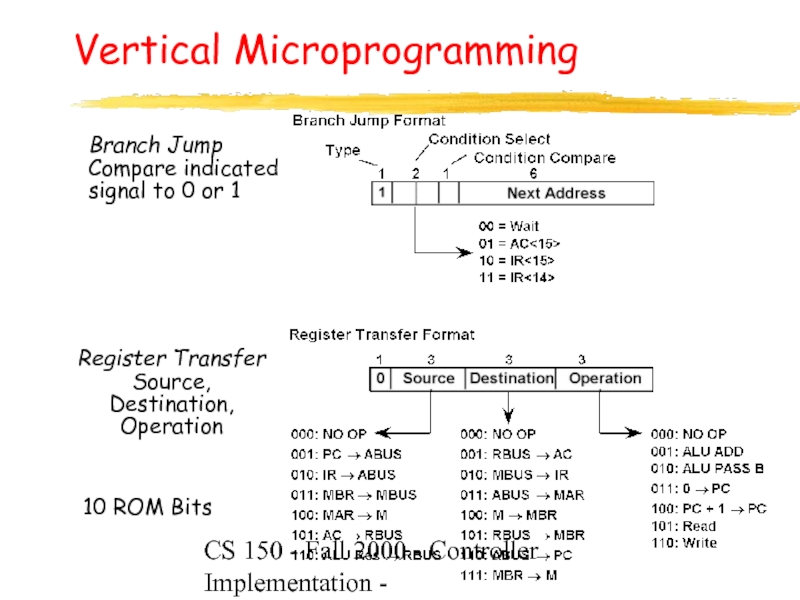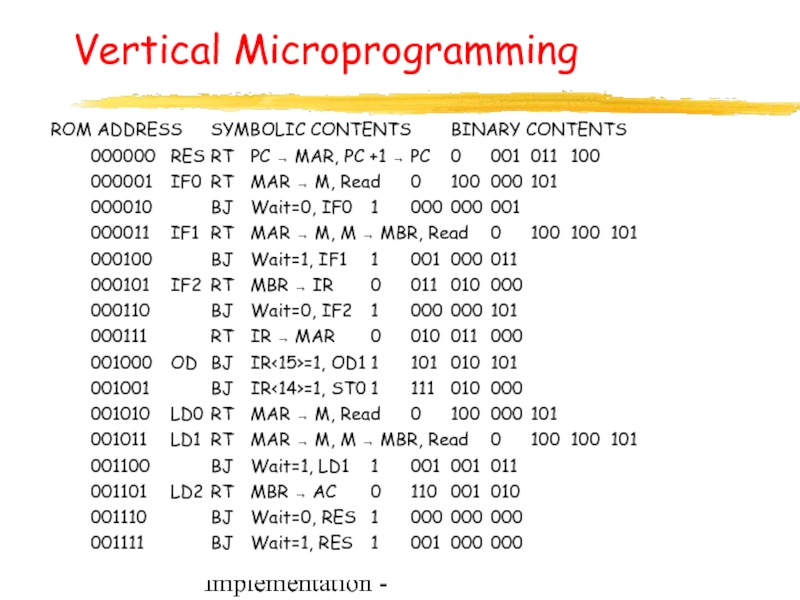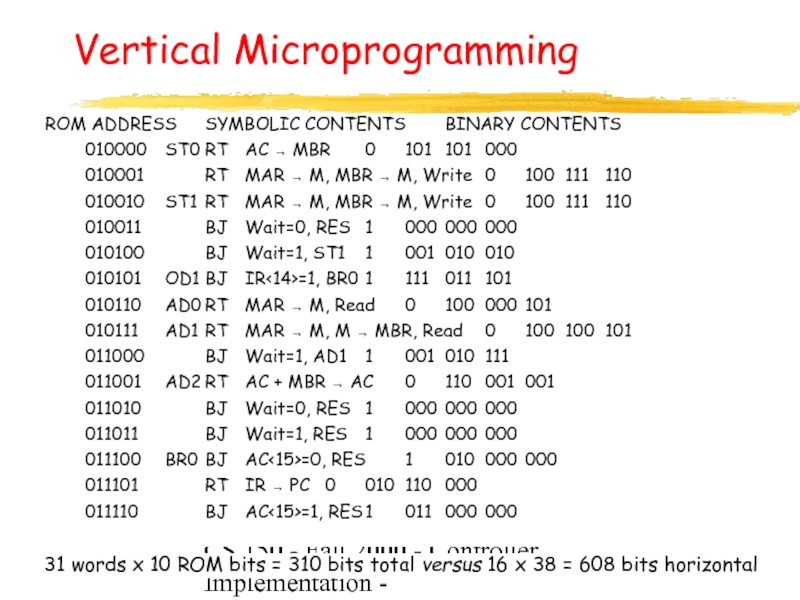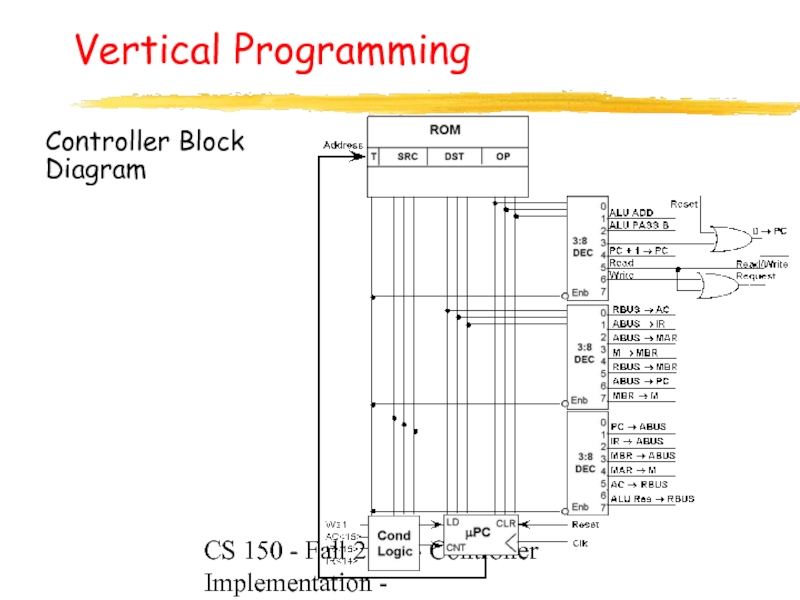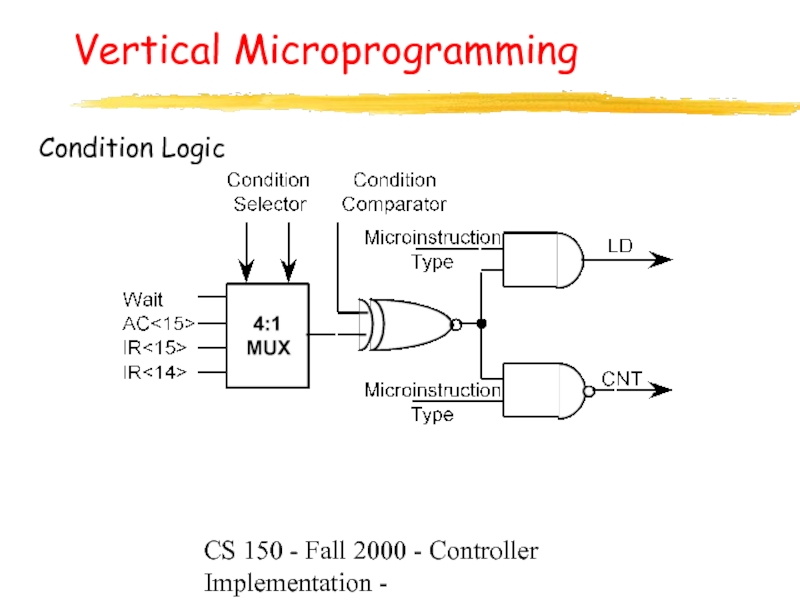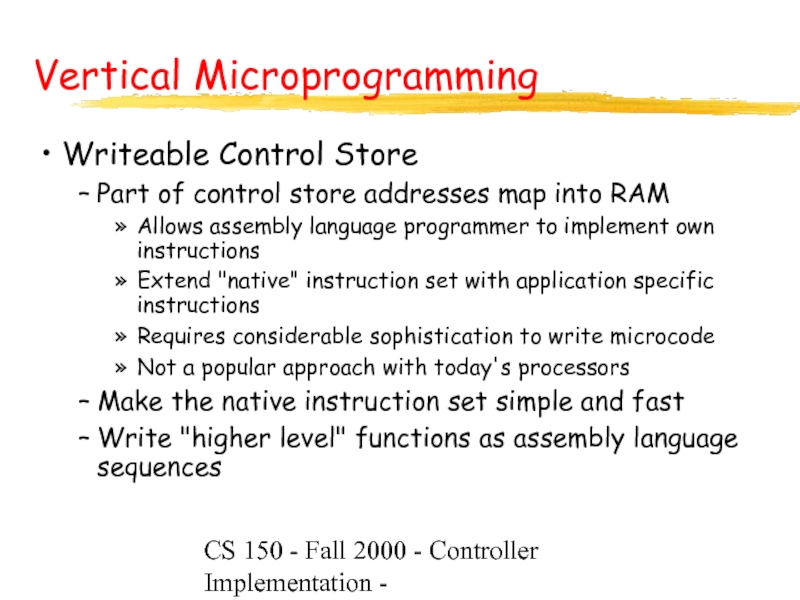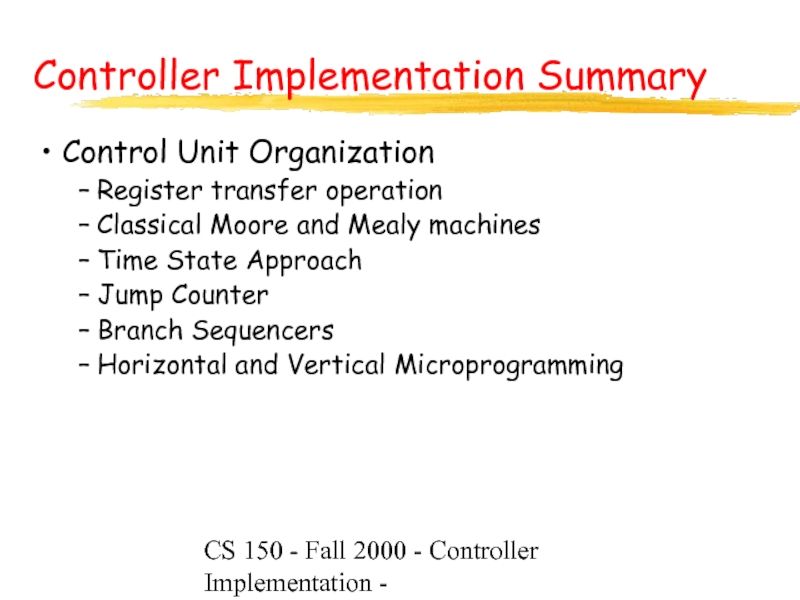- Главная
- Разное
- Дизайн
- Бизнес и предпринимательство
- Аналитика
- Образование
- Развлечения
- Красота и здоровье
- Финансы
- Государство
- Путешествия
- Спорт
- Недвижимость
- Армия
- Графика
- Культурология
- Еда и кулинария
- Лингвистика
- Английский язык
- Астрономия
- Алгебра
- Биология
- География
- Детские презентации
- Информатика
- История
- Литература
- Маркетинг
- Математика
- Медицина
- Менеджмент
- Музыка
- МХК
- Немецкий язык
- ОБЖ
- Обществознание
- Окружающий мир
- Педагогика
- Русский язык
- Технология
- Физика
- Философия
- Химия
- Шаблоны, картинки для презентаций
- Экология
- Экономика
- Юриспруденция
Overview презентация
Содержание
- 1. Overview
- 2. CS 150 - Fall 2000 - Controller
- 3. CS 150 - Fall 2000 - Controller
- 4. CS 150 - Fall 2000 - Controller
- 5. CS 150 - Fall 2000 - Controller
- 6. CS 150 - Fall 2000 - Controller
- 7. CS 150 - Fall 2000 - Controller
- 8. CS 150 - Fall 2000 - Controller
- 9. CS 150 - Fall 2000 - Controller
- 10. CS 150 - Fall 2000 - Controller
- 11. CS 150 - Fall 2000 - Controller
- 12. CS 150 - Fall 2000 - Controller
- 13. CS 150 - Fall 2000 - Controller
- 14. CS 150 - Fall 2000 - Controller
- 15. CS 150 - Fall 2000 - Controller
- 16. CS 150 - Fall 2000 - Controller
- 17. CS 150 - Fall 2000 - Controller
- 18. CS 150 - Fall 2000 - Controller
- 19. CS 150 - Fall 2000 - Controller
- 20. CS 150 - Fall 2000 - Controller
- 21. CS 150 - Fall 2000 - Controller
- 22. CS 150 - Fall 2000 - Controller
- 23. CS 150 - Fall 2000 - Controller
- 24. CS 150 - Fall 2000 - Controller
- 25. CS 150 - Fall 2000 - Controller
- 26. CS 150 - Fall 2000 - Controller
- 27. CS 150 - Fall 2000 - Controller
- 28. CS 150 - Fall 2000 - Controller
- 29. CS 150 - Fall 2000 - Controller
- 30. CS 150 - Fall 2000 - Controller
- 31. CS 150 - Fall 2000 - Controller
- 32. CS 150 - Fall 2000 - Controller
- 33. CS 150 - Fall 2000 - Controller
- 34. CS 150 - Fall 2000 - Controller
- 35. CS 150 - Fall 2000 - Controller
- 36. CS 150 - Fall 2000 - Controller
- 37. CS 150 - Fall 2000 - Controller
- 38. CS 150 - Fall 2000 - Controller
- 39. CS 150 - Fall 2000 - Controller
- 40. CS 150 - Fall 2000 - Controller
- 41. CS 150 - Fall 2000 - Controller
- 42. CS 150 - Fall 2000 - Controller
- 43. CS 150 - Fall 2000 - Controller
- 44. CS 150 - Fall 2000 - Controller
- 45. CS 150 - Fall 2000 - Controller Implementation - Vertical Programming Controller Block Diagram
- 46. CS 150 - Fall 2000 - Controller Implementation - Vertical Microprogramming Condition Logic
- 47. CS 150 - Fall 2000 - Controller
- 48. CS 150 - Fall 2000 - Controller
Слайд 1CS 150 - Fall 2000 - Controller Implementation -
Overview
Alternative controller
classical Moore and Mealy machines
jump counters
microprogramming (ROM) based approaches
branch sequencers
horizontal microcode
vertical microcode
Слайд 2CS 150 - Fall 2000 - Controller Implementation -
Alternative Ways
"Random Logic" based on Moore and Mealy Design
Classical Finite State Machine Design
Divide and Conquer Approach: Time-State Method
Partition FSM into multiple communicating FSMs
Exploit MSI Components: Jump Counters
Counters, Multiplexors, Decoders
Microprogramming: ROM-based methods
Direct encoding of next states and outputs
Слайд 3CS 150 - Fall 2000 - Controller Implementation -
Random Logic
Perhaps
Contrast with structured logic: PAL/PLA, PGA, ROM
Could just as easily construct Moore and Mealy machines with these components
Слайд 4CS 150 - Fall 2000 - Controller Implementation -
Moore Machine
State
Note capture of MBR
in these states
Слайд 5CS 150 - Fall 2000 - Controller Implementation -
Memory-Register Interface
Valid data latched on IF2 to IF3 transition
because data must be
valid before Wait can go low
Слайд 6CS 150 - Fall 2000 - Controller Implementation -
Moore Machine
16 states, 4 bit state register
Next State Logic: 9 Inputs, 4 Outputs
Output Logic: 4 Inputs, 18 Outputs
These can be implemented via ROM
or PAL/PLA
Next State: 512 x 4 bit ROM
Output: 16 x 18 bit ROM
Слайд 7CS 150 - Fall 2000 - Controller Implementation -
Moore Machine
Reset Wait IR<15> IR<14> AC<15> Current State Next State Register Transfer Ops
1 X X X X X RES (0000)
0 X X X X RES (0000) IF0 (0001) 0 → PC
0 X X X X IF0 (0001) IF1 (0001) PC → MAR, PC + 1 → PC
0 0 X X X IF1 (0010) IF1 (0010)
0 1 X X X IF1 (0010) IF2 (0011)
0 1 X X X IF2 (0011) IF2 (0011) MAR → Mem, Read,
0 0 X X X IF2 (0011) IF3 (0100) Request, Mem → MBR
0 0 X X X IF3 (0100) IF3 (0100) MBR → IR
0 1 X X X IF3 (0100) OD (0101)
0 X 0 0 X OD (0101) LD0 (0110)
0 X 0 1 X OD (0101) ST0 (1001)
0 X 1 0 X OD (0101) AD0 (1011)
0 X 1 1 X OD (0101) BR0 (1110)
Слайд 8CS 150 - Fall 2000 - Controller Implementation -
Moore Machine
Reset Wait IR<15> IR<14> AC<15> Current State Next State Register Transfer Ops
0 X X X X LD0 (0110) LD1 (0111) IR → MAR
0 1 X X X LD1 (0111) LD1 (0111) MAR → Mem, Read,
0 0 X X X LD1 (0111) LD2 (1000) Request, Mem → MBR
0 X X X X LD2 (1000) IF0 (0001) MBR → AC
0 X X X X ST0 (1001) ST1 (1010) IR → MAR, AC → MBR
0 1 X X X ST1 (1010) ST1 (1010) MAR → Mem, Write,
0 0 X X X ST1 (1010) IF0 (0001) Request, MBR → Mem
0 X X X X AD0 (1011) AD1 (1100) IR → MAR
0 1 X X X AD1 (1100) AD1 (1100) MAR → Mem, Read,
0 0 X X X AD1 (1100) AD2 (1101) Request, Mem → MBR
0 X X X X AD2 (1101) IF0 (0001) MBR + AC → AC
0 X X X 0 BR0 (1110) IF0 (0001)
0 X X X 1 BR0 (1110) BR1 (1111)
0 X X X X BR1 (1111) IF0 (0001) IR → PC
Слайд 9CS 150 - Fall 2000 - Controller Implementation -
Moore Machine
Observations:
Extensive use of Don't Cares
Inputs used only in a small number of state
e.g., AC<15> examined only in BR0 state
IR<15:14> examined only in OD state
Some outputs always asserted in a group
ROM-based implementations cannot take advantage of don't cares
However, ROM-based implementation can skip state assignment step
Слайд 10CS 150 - Fall 2000 - Controller Implementation -
Moore Machine
Assume PAL/PLA
implementation style
First idea:
run ESPRESSO
with naive state
assignment
.i 9
.o 4
.ilb reset wait ir15 ir14 ac15 q3 q2 q1 q0
.ob p3 p2 p1 p0
.p 26
1---- ---- 0000
0---- 0001 0001
00--- 0010 0010
01--- 0010 0011
01--- 0011 0011
00--- 0011 0100
00--- 0100 0100
01--- 0100 0101
0-00- 0101 0110
0-01- 0101 1001
0-10- 0101 1011
0-11- 0101 1110
0---- 0110 0111
01--- 0111 0111
00--- 0111 1000
0---- 1000 0001
0---- 1001 1010
01--- 1010 1010
00--- 1010 0001
0---- 1011 1100
01--- 1100 1100
00--- 1100 1101
0---- 1101 0001
0---0 1110 0001
0---1 1110 1111
0---- 1111 0001
.e
.i 9
.o 4
.ilb reset wait ir15 ir14 ac15 q3 q2 q1 q0
.ob p3 p2 p1 p0
.p 21
0-00-0101 0110
0-01-0101 1001
0-11-0101 1110
0-10-0101 1011
01---1010 1010
00---0111 1000
00----011 0100
0----1000 0001
0---11110 1110
01---011- 0100
0----0001 0001
01---01-0 0001
0----1001 1010
0----1011 1100
00---1--0 0001
0----1100 1100
0----0-10 0010
0-----110 0001
0----11-1 0001
0----01-0 0100
01---0-1- 0011
.e
21 product terms
Compare with 512
product terms in ROM
implementation!
Слайд 11CS 150 - Fall 2000 - Controller Implementation -
Moore Machine
NOVA assignment does better
NOVA State Assignment SUMMARY
onehot_products = 22
best_products = 18
best_size = 414
states[0]:IF0 Best code: 0000
states[1]:IF1 Best code: 1011
states[2]:IF2 Best code: 1111
states[3]:IF3 Best code: 1101
states[4]:OD Best code: 0001
states[5]:LD0 Best code: 0010
states[6]:LD1 Best code: 0011
states[7]:LD2 Best code: 0100
states[8]:ST0 Best code: 0101
states[9]:ST1 Best code: 0110
states[10]:AD0 Best code: 0111
states[11]:AD1 Best code: 1000
states[12]:AD2 Best code: 1001
states[13]:BR0 Best code: 1010
states[14]:BR1 Best code: 1100
states[15]:RES Best code: 1110
18 product terms
improves on 21!
Слайд 12CS 150 - Fall 2000 - Controller Implementation -
Synchronizer
Circuitry at
Inputs
Outputs
Synchronous Mealy Machines
Standard Mealy Machine has asynchronous outputs
These change in response to input changes, independent of clock
Revise Mealy Machine design so outputs change only on clock edges
One approach: non-overlapping clocks
Слайд 13CS 150 - Fall 2000 - Controller Implementation -
Synchronous Mealy
Case I: Synchronizers at Inputs and Outputs
A asserted in Cycle 0, ƒ becomes asserted after 2 cycle delay!
This is clearly overkill!
Слайд 14CS 150 - Fall 2000 - Controller Implementation -
Synchronous Mealy
Case II: Synchronizers on Inputs
A asserted in Cycle 0, ƒ follows in next cycle
Same as using delayed signal (A') in Cycle 1!
Слайд 15CS 150 - Fall 2000 - Controller Implementation -
Synchronous Mealy
Case III: Synchronized Outputs
A asserted during Cycle 0, ƒ' asserted in next cycle
Effect of ƒ delayed one cycle
Слайд 16CS 150 - Fall 2000 - Controller Implementation -
Synchronous Mealy
Implications for Processor FSM Already Derived
Consider inputs: Reset, Wait, IR<15:14>, AC<15>
Latter two already come from registers, and are sync'd to clock
Possible to load IR with new instruction in one state & perform multiway branch on opcode in next state
Best solution for Reset and Wait: synchronized inputs
Place D flipflops between these external signals and the
control inputs to the processor FSM
Sync'd versions of Reset and Wait delayed by one clock cycle
Слайд 17CS 150 - Fall 2000 - Controller Implementation -
Time State
Overview
Classical Approach: Monolithic Implementations
Alternative "Divide & Conquer" Approach:
Decompose FSM into several simpler communicating FSMs
Time state FSM (e.g., IFetch, Decode, Execute)
Instruction state FSM (e.g., LD, ST, ADD, BRN)
Condition state FSM (e.g., AC < 0, AC ≠ 0)
Слайд 18CS 150 - Fall 2000 - Controller Implementation -
Time State
Time State FSM
Most instructions follow same basic sequence
Differ only in detailed execution sequence
Time State FSM can be parameterized by
opcode and AC states
Instruction State:
stored in IR<15:14>
Condition State:
stored in AC<15>
Слайд 19CS 150 - Fall 2000 - Controller Implementation -
Time State
Generation of Microoperations
Слайд 20CS 150 - Fall 2000 - Controller Implementation -
Jump Counter
Concept
Implement
Pure jump counter: only one of four possible next states
Single "Jump State"
function of the current
state
Hybrid jump counter:
Multiple "Jump States" — function of current state + inputs
Слайд 21CS 150 - Fall 2000 - Controller Implementation -
Jump Counters
Pure
Logic blocks implemented via discrete logic, PALs/PLAs, ROMs
NOTE: No inputs to
jump state logic
Слайд 22CS 150 - Fall 2000 - Controller Implementation -
Jump Counters
Problem
Difficult to implement multi-way branches
Logical State Diagram
Pure Jump Counter
State Diagram
Extra States:
Слайд 23CS 150 - Fall 2000 - Controller Implementation -
Jump Counters
Hybrid
Load inputs are
function of state
and FSM inputs
Слайд 24CS 150 - Fall 2000 - Controller Implementation -
Jump Counters
Implementation
State assignment
attempts to take
advantage of
sequential states
Слайд 25CS 150 - Fall 2000 - Controller Implementation -
Jump Counters
Implementation
CNT = (s0 + s5 + s8 + s10) + Wait • (s1 + s3) + Wait • (s2 + s6 + s9 + s11)
CNT = Wait • (s1 + s3) + Wait • (s2 + s6 + s9 + s11)
CLR = Reset + s7 + s12 + s13 + (s9 • Wait)
CLR = Reset • s7 • s12 • s13 • (s9 + Wait)
LD = s4
Address
00
01
10
11
Contents (Symbolic State)
0101 (LD0)
1000 (ST0)
1010 (AD0)
1101 (BR0)
Contents of Jump State ROM
Слайд 26CS 150 - Fall 2000 - Controller Implementation -
Jump Counters
Implementation
Implement CNT
using active lo
PAL
NOTE: Active lo
outputs from
decoder
Implement CLR
Слайд 27CS 150 - Fall 2000 - Controller Implementation -
Jump Counter
CLR,
implemented via
Mux Logic
Active Lo outputs:
hi input inverted at
the output
Note that CNT is
active hi on counter
so invert MUX inputs!
CLR = CLRm + Reset
CLR = CLRm + Reset
Слайд 28CS 150 - Fall 2000 - Controller Implementation -
Jump Counters
Microoperation
0 → PC = Reset
PC + 1 → PC = S0
PC → MAR = S0
MAR → Memory Address Bus =
Wait•(S1 + S2 + S5 + S6 + S8 + S9 + S11 + S12)
Memory Data Bus → MBR = Wait•(S2 + S6 + S11)
MBR → Memory Data Bus = Wait•(S8 + S9)
MBR → IR = Wait•S3
MBR → AC = Wait•S7
AC → MBR = IR15•IR14•S4
AC + MBR → AC = Wait•S12
IR<13:0> → MAR = (IR15•IR14 + IR15•IR14 + IR15•IR14)•S4
IR<13:0> → PC = AC15•S13
1 → Read/Write = Wait•(S1 + S2 + S5 + S6 + S11 + S12)
0 → Read/Write = Wait•(S8 + S9)
1 → Request = Wait•(S1 + S2 + S5 + S6 + S8 + S9 + S11 + S12)
Jump Counters: CNT, CLR, LD function of current state + Wait
Why not store these as outputs of the Jump State ROM?
Make Wait and Current State part of ROM address
32 x as many words, 7 bits wide
Слайд 29CS 150 - Fall 2000 - Controller Implementation -
Branch Sequencers
Concept
Implement
Address ROM with current state and inputs
Problem: ROM doubles in size for each additional input
Note: Jump counter trades off ROM size vs. external logic
Only jump states kept in ROM
Even in hybrid approach, state + input subset form ROM address
Branch Sequencer: between the extremes
Next State stored in ROM
Each state limited to small number of next states
Always a power of 2
Observe: only a small set of inputs are examined in any state
Слайд 30CS 150 - Fall 2000 - Controller Implementation -
Branch Sequencers
4
Current State selects two inputs to form part of ROM address
These select one of four possible next states (and output sets)
Every state has exactly four possible next states
Слайд 31CS 150 - Fall 2000 - Controller Implementation -
Branch Sequencer
Processor
Alpha, Beta multiplexer input setup
Слайд 32CS 150 - Fall 2000 - Controller Implementation -
Example Processor
ROM ADDRESS ROM CONTENTS
(Reset, Current State, a, b) Next State Register Transfer Operations
RES 0 0000 X X 0001 (IF0) PC → MAR, PC + 1 → PC
IF0 0 0001 0 0 0001 (IF0)
0 0001 1 1 0010 (IF1) MAR → Mem, Read, Request
IF1 0 0010 0 0 0011 (IF2) MAR → Mem, Read, Request
0 0010 1 1 0010 (IF1) Mem → MBR
IF2 0 0011 0 0 0011 (IF2)
0 0011 1 1 0100 (OD) MBR → IR
OD 0 0100 0 0 0101 (LD0) IR → MAR
0 0100 0 1 1000 (ST0) IR → MAR, AC → MBR
0 0100 1 0 1001 (AD0) IR → MAR
0 0100 1 1 1101 (BR0) IR → MAR
Слайд 33CS 150 - Fall 2000 - Controller Implementation -
Example Processor
ROM ADDRESS ROM CONTENTS
(Reset, Current State, a, b) Next State Register Transfer Operations
LD0 0 0101 X X 0110 (LD1) MAR → Mem, Read, Request
LD1 0 0110 0 0 0111 (LD2) Mem → MBR
0 0110 1 1 0110 (LD1) MAR → Mem, Read, Request
LD2 0 0111 X X 0000 (RES) MBR → AC
ST0 0 1000 X X 1001 (ST1) MAR → Mem, Write, Request, MBR → Mem
ST1 0 1001 0 0 0000 (RES)
0 1001 1 1 1001 (ST1) MAR → Mem, Write, Request, MBR → Mem
AD0 0 1010 X X 1011 (AD1) MAR → Mem, Read, Request
AD1 0 1011 0 0 1100 (AD2)
0 1011 1 1 1011 (AD1) MAR → Mem, Read, Request
AD2 0 1100 X X 0000 (RES) MBR + AC → AC
BR0 0 1101 0 0 0000 (RES)
0 1101 1 1 0000 (RES) IR → PC
Слайд 34CS 150 - Fall 2000 - Controller Implementation -
Branch Sequencers
Alternative
Horizontal
Implementation
Input
Much fewer inputs than unique states!
In example FSM, input MUX can be 2:1!
Adding length to ROM word saves on bits vs. doubling words
Vertical format: (14 + 4) x 64 = 1152 ROM bits
Horizontal format: (14 + 4 x 4 + 2) x 16 = 512 ROM bits
Слайд 35CS 150 - Fall 2000 - Controller Implementation -
Microprogramming
How to
Implement control signals by storing 1's and 0's in a ROM
Horizontal vs. vertical microprogramming
Horizontal: 1 ROM output for each control signal
Vertical: encoded control signals in ROM, decoded externally
some mutually exclusive signals can be combined
helps reduce ROM length
Слайд 36CS 150 - Fall 2000 - Controller Implementation -
Microprogramming
Register Transfer/Microoperations
14
PC → ABUS
IR → ABUS
MBR → ABUS
RBUS → AC
AC → ALU A
MBUS → ALU B
ALU ADD
ALU PASS B
MAR → Address Bus
MBR → Data Bus
ABUS → IR
ABUS → MAR
Data Bus → MBR
RBUS → MBR
MBR → MBUS
0 → PC
PC + 1 → PC
ABUS → PC
Read/Write
Request
AC → RBUS
ALU Result → RBUS
Слайд 37CS 150 - Fall 2000 - Controller Implementation -
Horizontal Microprogramming
Horizontal
α, β Mux bits
4 x 4 Next State bits
22 Control operation bits
40 bits total
Слайд 38CS 150 - Fall 2000 - Controller Implementation -
Horizontal Microprogramming
Moore
Alpha inputs: 0 = Wait, 1 = IR<15>
Beta inputs: 0 = AC<15>, 1 = IR<14>
Слайд 39CS 150 - Fall 2000 - Controller Implementation -
Horizontal Microprogramming
Advantages:
most flexibility -- complete parallel access to datapath control points
Disadvantages:
very long control words -- 100+ bits for real processors
Output Encodings:
Group mutually exclusive signals
Use external logic to decode
NOTE: Not all microoperation combinations make sense!
Example:
0 → PC, PC + 1 → PC, ABUS → PC mutually exclusive
Save ROM bit with external 2:4 Decoder
Слайд 40CS 150 - Fall 2000 - Controller Implementation -
Horizontal Microprogramming
Partially
Control Outputs
Слайд 41CS 150 - Fall 2000 - Controller Implementation -
More extensive
Typically use multiple microword formats:
Horizontal microcode -- next state + control bits in same word
Separate formats for control outputs and "branch jumps"
may require several microwords in a sequence to implement same function as single horizontal word
In the extreme, very much like assembly language programming
Vertical Microprogramming
Слайд 42CS 150 - Fall 2000 - Controller Implementation -
Vertical Microprogramming
Branch
Compare indicated
signal to 0 or 1
Register Transfer
Source,
Destination,
Operation
10 ROM Bits
Слайд 43CS 150 - Fall 2000 - Controller Implementation -
Vertical Microprogramming
ROM
000000 RES RT PC → MAR, PC +1 → PC 0 001 011 100
000001 IF0 RT MAR → M, Read 0 100 000 101
000010 BJ Wait=0, IF0 1 000 000 001
000011 IF1 RT MAR → M, M → MBR, Read 0 100 100 101
000100 BJ Wait=1, IF1 1 001 000 011
000101 IF2 RT MBR → IR 0 011 010 000
000110 BJ Wait=0, IF2 1 000 000 101
000111 RT IR → MAR 0 010 011 000
001000 OD BJ IR<15>=1, OD1 1 101 010 101
001001 BJ IR<14>=1, ST0 1 111 010 000
001010 LD0 RT MAR → M, Read 0 100 000 101
001011 LD1 RT MAR → M, M → MBR, Read 0 100 100 101
001100 BJ Wait=1, LD1 1 001 001 011
001101 LD2 RT MBR → AC 0 110 001 010
001110 BJ Wait=0, RES 1 000 000 000
001111 BJ Wait=1, RES 1 001 000 000
Слайд 44CS 150 - Fall 2000 - Controller Implementation -
Vertical Microprogramming
ROM
010000 ST0 RT AC → MBR 0 101 101 000
010001 RT MAR → M, MBR → M, Write 0 100 111 110
010010 ST1 RT MAR → M, MBR → M, Write 0 100 111 110
010011 BJ Wait=0, RES 1 000 000 000
010100 BJ Wait=1, ST1 1 001 010 010
010101 OD1 BJ IR<14>=1, BR0 1 111 011 101
010110 AD0 RT MAR → M, Read 0 100 000 101
010111 AD1 RT MAR → M, M → MBR, Read 0 100 100 101
011000 BJ Wait=1, AD1 1 001 010 111
011001 AD2 RT AC + MBR → AC 0 110 001 001
011010 BJ Wait=0, RES 1 000 000 000
011011 BJ Wait=1, RES 1 000 000 000
011100 BR0 BJ AC<15>=0, RES 1 010 000 000
011101 RT IR → PC 0 010 110 000
011110 BJ AC<15>=1, RES 1 011 000 000
31 words x 10 ROM bits = 310 bits total versus 16 x 38 = 608 bits horizontal
Слайд 45CS 150 - Fall 2000 - Controller Implementation -
Vertical Programming
Controller
Diagram
Слайд 47CS 150 - Fall 2000 - Controller Implementation -
Vertical Microprogramming
Writeable
Part of control store addresses map into RAM
Allows assembly language programmer to implement own instructions
Extend "native" instruction set with application specific instructions
Requires considerable sophistication to write microcode
Not a popular approach with today's processors
Make the native instruction set simple and fast
Write "higher level" functions as assembly language sequences
Слайд 48CS 150 - Fall 2000 - Controller Implementation -
Controller Implementation
Control Unit Organization
Register transfer operation
Classical Moore and Mealy machines
Time State Approach
Jump Counter
Branch Sequencers
Horizontal and Vertical Microprogramming
